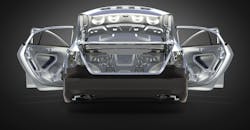Die-Release and Die-Spray Technologies Improve Productivity
Cost optimization and improved productivity and product quality are driving diecasting strategies, particularly in the face of global competition and the need to produce more complex components. Automotive design and manufacturing are prompting to diecasters to take on more complex, lightweight, components for powertrain, chassis, and structural parts. In turn, this has guided investments in larger high-pressure diecasting machines and more expensive tooling, which has manufacturers seeking to improve productivity, process reliability, and product quality, and to extend die service.
The main purpose of a die-release agent is to allow clean part release and provide a release film that minimizes die soldering, and uniform coverage is critical to both process reliability and the finished product quality. Standard water-based lubricants evaporate in contact with a hot steel die, leaving a lubricant coating. This is a critical stage, because too much lubricant means liquid cannot evaporate quickly enough when molten metal is injected; and too little lubricant may result in poor material flow (i.e., "die soldering"), and then causing surface defects and porosity that reduce finished product quality.
Changes in industrial diecasting mean that die complexity is making these concerns even more critical, as manufacturers seek to achieve a consistent level of lubricant coverage across the mold, including cavities where excessive amounts of water-based lubricants typically remain, causing cold flow, porosity, and staining on casting surfaces.
The solution is electrostatic spray technology, according to Tim Butler, Ultraseal Intl. Group special projects director. WFR-EC, a lubricant developed by Lubrolene, has an electrostatic charge added to the die release agent which, when applied through a specially developed electrostatic spray gun, "creates a wrap-around effect and ensures uniform coverage of the release agent, irrespective of die complexity." It also reduces soldering problems without relying on water-based lubricants, for higher and more consistent finished-product quality.
Adding an electrostatic charge to Lubrolene WFR-EC also improves adhesion and provides more consistent oil-film formation – both critical for uniform die coverage and a smooth release. Better adhesion leads to reduced material waste and improved cycle times.
Typically, applying a water-based formula with an air-spray gun achieves just 4% adhesion efficiency. Lubrolene’s specially developed spray gun improves application of Lubrolene WFR-EC and achieves >80% adhesion efficiency compared to water-based die lubricants.
Applying die lubricant is a fast and repetitive process, but saving a few seconds can accumulate time savings that will improve productivity. Standard air-spray guns must spray from multiple angles to deliver full die coverage and adhesion, which takes time and may degrade quality thanks to uneven coverage, particularly for complex molds.
By using electrostatic attraction, the Lubrolene electrostatic gun can cover more uniformly and adhere to a much broader area, with no need to spray from various angles. Typical spray time (even HPDC machines larger than 4,000 mt) are measured in seconds with Lubrolene WFR-EC and specially designed Lubrolene spray heads. This will reduce cycle times, increase throughput, and raise productivity. Also, as Lubrolene die-spraying equipment is modular it can be adapted to suit any size of diecasting machine, and its low-maintenance design improves reliability.
A further benefit to Lubrolene WFR-EC is extended tool service life. Water-based release agents allow rapid die-surface cooling, leading to extreme temperature fluctuations which can induce cracks on the die surface as a result of repeated compressive and tensile stresses. With cracks typically starting after several hundred shots, the tool’s service life is limited to <120,000 shots for a typical diecasting machine.
Thanks to its very small spray amount, Lubrolene WFR-EC reduces the rapid cooling effect, minimizing thermal stresses in dies. With die-service life being extended up to six times, cost savings can be estimated at up to $540,000/year. Extended service life also would result in reduced tooling requirements, further reducing operating costs by up to 20%.
Faster die-spraying means a significant reduction in cycle times, and more uniform adhesion results in greater process reliability, with reduced material waste and reduced stress on die tools, thereby increasing die service life.
